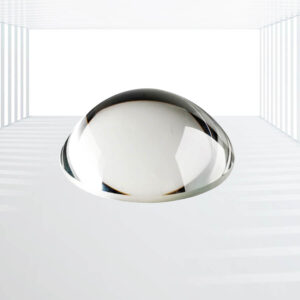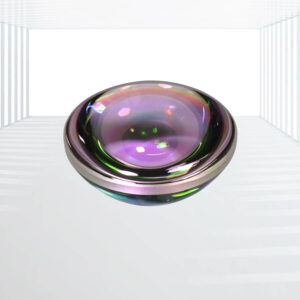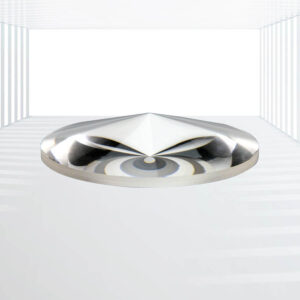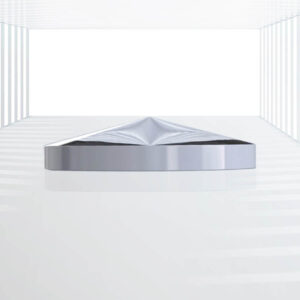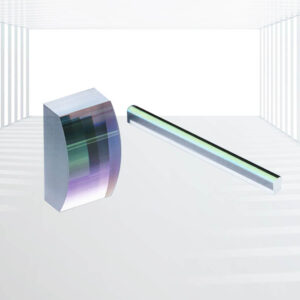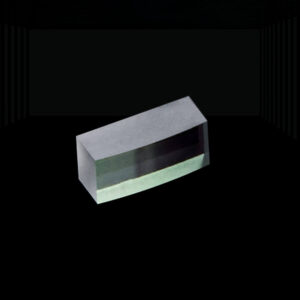λ4-λ UV Fused Silica Plano-convex Lenses
Exceptional Optical Transmission and Broad Wavelength Range:
- High Transmission: UV fused silica exhibits high transmission across a broad wavelength range, including the deep UV region below 400 nm (λ4-λ). This ensures maximum light throughput and minimal loss in optical systems.
- Broadband Capability: Suitable for wavelengths from the deep UV to the near-infrared (NIR), making them versatile for a variety of applications requiring high-quality optics.
Superior Physical and Optical Properties:
- Low Thermal Expansion Coefficient: Compared to other materials like N-BK7, UV fused silica has a lower coefficient of thermal expansion, which helps maintain the stability of optical systems under temperature variations.
- Excellent Homogeneity: UV fused silica boasts better optical homogeneity, minimizing optical errors caused by material inhomogeneities.
- Virtually No Laser-Induced Fluorescence: In the UV region, it exhibits virtually no laser-induced fluorescence, which is crucial for applications requiring high signal-to-noise ratios.
Precision Manufacturing and Coating Technology:
- Tight Tolerance Control: These lenses are precisely polished to meet stringent tolerance requirements, including surface flatness, surface quality, and focal length tolerance, minimizing wavefront distortions.
- High-Quality Anti-Reflection Coatings: Available with anti-reflection (AR) coatings tailored to specific wavelength ranges, reducing reflectance and enhancing transmission.
Durability and Reliability:
- High Laser Damage Threshold: Capable of withstanding high-energy laser pulses, making them suitable for demanding laser applications.
- Long-Term Stability: Their excellent physical and optical properties ensure stable performance over extended periods of use.
Applications: Detectors, Imaging Instruments, Lasers, Fiber Lasers, etc.
A Plano-Convex (PCX) lens is an optical element with a positive focal length and a flat-spherical surface profile. These lenses are designed for various optical applications including light focusing, collection, and collimation. They can also be used to decrease the focal length of optical assemblies and magnify images. Compared to biconvex lenses, plano-convex lenses have two non-identical sides, making them ideal for infinite conjugate ratios (objective distance: image distance). However, they still effectively reduce spherical aberrations when the absolute conjugate ratio is greater than 5:1. For conjugate ratios below 5:1, using plano-convex lenses in pairs or opting for a biconvex lens is recommended.
UV Fused Silica is the amorphous form of Silicon Dioxide, known for its superior transmission in the UV region and usability across the UV to Near-infrared (NIR) spectrum. It boasts low thermal expansion, high optical homogeneity, chemical inertness, mechanical strength, and an absence of fluorescence under UV radiation. Compared to N-BK7, UV Fused Silica is more reliable in high-temperature environments and offers better transmission in the ultraviolet spectrum.
Specifications:
| Lens Form | Plano-convex Lens |
| Material | UV Fused Silica (JGS1) |
| Working Wavelength Range | 200-2200nm |
| Irregularity@632.8nm | λ/4-λ |
| Surface Quality (S/D) | 40/20 |
| Coating | Uncoated, V-coating, BBAR coating |
| Clear Aperture | >90% |
| Centering Error | ≤3 arc min |
| Protective Chamfer | 0.2mmx45° |
| Diameters | 6-75mm, or custom |
Features:
1.Exceptional Optical Transmission and Broad Wavelength Range:
- High Transmission: UV fused silica exhibits high transmission across a broad wavelength range, including the deep UV region below 400 nm (λ4-λ). This ensures maximum light throughput and minimal loss in optical systems.
- Broadband Capability: Suitable for wavelengths from the deep UV to the near-infrared (NIR), making them versatile for a variety of applications requiring high-quality optics.
2. Superior Physical and Optical Properties
- Low Thermal Expansion Coefficient: Compared to other materials like N-BK7, UV fused silica has a lower coefficient of thermal expansion, which helps maintain the stability of optical systems under temperature variations.
- Excellent Homogeneity: UV fused silica boasts better optical homogeneity, minimizing optical errors caused by material inhomogeneities.
- Virtually No Laser-Induced Fluorescence: In the UV region, it exhibits virtually no laser-induced fluorescence, which is crucial for applications requiring high signal-to-noise ratios.
3. Precision Manufacturing and Coating Technology:
- Tight Tolerance Control: These lenses are precisely polished to meet stringent tolerance requirements, including surface flatness, surface quality, and focal length tolerance, minimizing wavefront distortions.
- High-Quality Anti-Reflection Coatings: Available with anti-reflection (AR) coatings tailored to specific wavelength ranges, reducing reflectance and enhancing transmission.
4.Durability and Reliability:
- High Laser Damage Threshold: Capable of withstanding high-energy laser pulses, making them suitable for demanding laser applications.
- Long-Term Stability: Their excellent physical and optical properties ensure stable performance over extended periods of use.
Applications:
- Detectors: Enhancing light collection and focusing.
- Imaging Instruments: Improving image quality and reducing aberrations.
- Lasers: Focusing and collimating laser beams.
- Fiber Lasers: Efficient light coupling and transmission.
Kingwin Optics’ UV Fused Silica plano-convex lenses offer exceptional performance in diverse optical systems. With high optical quality, customizable specifications, and advanced coatings, these lenses provide a reliable solution for enhancing the efficiency and effectiveness of complex optical instruments.




